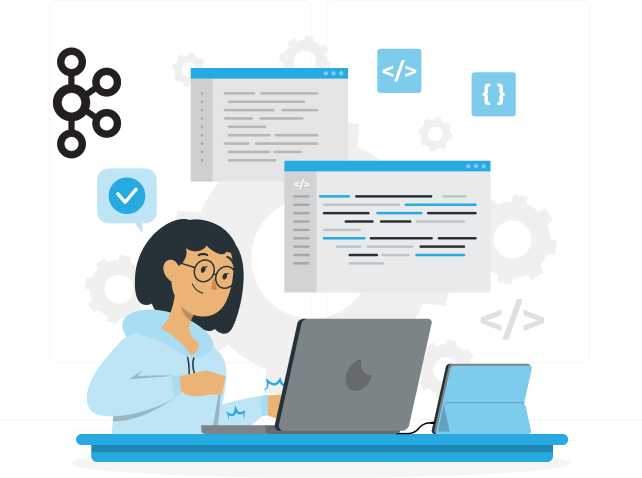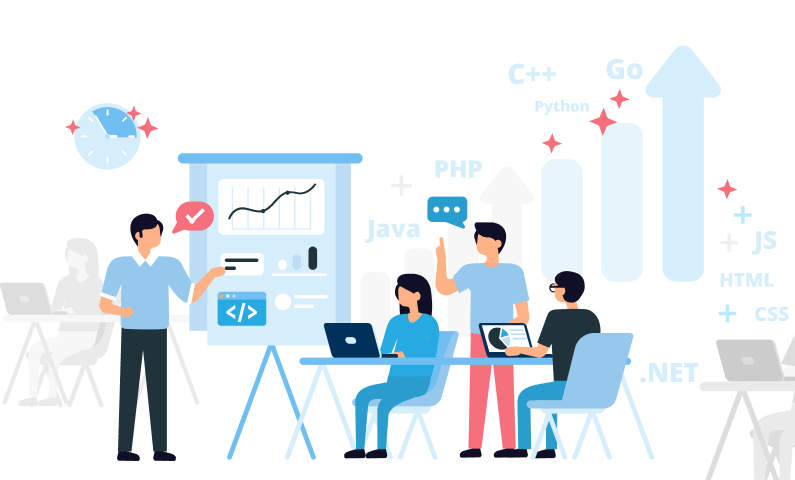Since organizations increasingly resort to digital transformation, there is no greater momentum for efficient software development and IT operations. DevOps represents a practice that combines software development, popularly known as ‘Dev’, with IT operations, also known as ‘Ops’. It has been considered one of the significant approaches towards the improvement of collaboration, increase of productivity and, hence, acceleration of delivery. Let’s write about the future of DevOps and discuss the trends of today’s world while explaining how business organizations may use DevOps as a boost toward efficiency in 2024 and beyond.
What is DevOps?
It is a culture that breaks the barriers between the development and operations teams. DevOps is not a collection of tools, but a large organizational cultural shift breaking down the silos that involve interaction between development teams and operations teams in order to enable streamlined processes, reduction of time-to-market, and software product quality.
The Role of DevOps in Contemporary Business
Business organizations are engaged in a fast-paced business environment requiring agility and responsiveness to changing business market demands. DevOps makes it possible for companies to:
Speed Software Delivery: DevOps and automation can significantly reduce the cycle time to develop and allow for quicker time to market.
Quality-Highest in class: DevOps catches all kinds of problems way earlier, much before deployment, through CI/CD practices enforced and therefore high-quality software.
Collaboration-Improved Communication: Cross-functional teams work toward common goals that make communication and teamwork across the spectrum better.
Speed Up Delivery of Features and Updates: The faster delivery of features and updates results in customers becoming more productive experiences, which therefore translates to higher satisfaction levels.
Key DevOps Trends Shaping the Future
As we enter 2024, several trends are emerging quite clearly that are likely to shape the future of DevOps. A clearer understanding of these trends will ensure that organizations are on the right track to stay ahead of the curve and maximize the benefits they are gaining by way of their DevOps initiatives.
1. GenAI in DevOps
The integration of GenAI in DevOps is giving organizations a dramatic shift from the previous way of handling their software development. GenAI can improve all the various aspects of a development lifecycle-from code generation, to improvement of testing processes. Organizations can simplify workflows, avoid errors introduced when working, and accelerate development timelines with AI-enabled tools.
Examples of GenAI Applications in DevOps:
Automated Code Generation: AI-using tools that generate code snippets from descriptions in natural language can order-of-magnitude speed up the development time.
Predictive Analytics: With AI algorithms, historical data can be scanned and issues in a deployment pipeline could be predicted. Thus, the team will capture such problems beforehand.
2. DevSecOps Becomes Popular
As organizational security concerns rise, the DevSecOps trend is paving the way for the transformation of how security must be integrated into the software development lifecycle. It focuses more on embedding security practices into each phase of development and assures not to make it a hindsight activity but rather a foundational activity.
Key Components DevSecOps
Security Automation: Security checks in CI/CD pipelines help detect vulnerabilities early within the development process.
Collaboration among teams: It helps in the establishment of shared responsibility for security outcomes by encouraging collaboration among the teams of developers, operations, and security.
3. Serverless Computing Adoption
Serverless computing has become the hot add-on in the DevOps spectrum since businesses are looking for ways to make infrastructure management simple, with more focus toward application development. This approach enables developers to code without worrying about managing the server or provisioning resources.
Advantages of Serverless Computing:
Cost Efficiency: The organisation only pays for the use of computational resources, hence bringing down the operating costs.
Scalability: Serverless architecture automatically scales according to the demand. Applications handle traffic bursts without human interference.
4. AI-Powered Automation
Automation is at the heart of DevOps practices and continues to be very relevant in DevOps. In 2024, we expect to see more widespread use of AI-based automation tools that can make deployments better, monitoring better, and incident response better. This can all predict problems before they occur, and pro-actively measures keep downtime to a minimum.
Examples of AI-Powered Automation Tools:
Intelligent Monitoring Solution: Machine learning algorithms with certain tools are used to analyze performance metrics and then detect anomalies in real-time.
These are AI-driven response systems that can automatically respond to any incidents based on the predefined rules, hence limiting the time taken when responding to such incidents.
5. Advanced Collaboration Tools
Today, with most people opting to work remotely, collaboration tools tailored for the DevOps team are changing. Improved communication among teams dispersed in locations facilitates project performance among such teams, even though they are in remote locations.
Characteristics of Good Collaboration Tools:
Instant Communication: How instant messaging apps make it easy for team members to connect with each other instantly.
Workflows: How they integrate with project management platforms like Jira to help teams assign tasks and track progress.
6. Continuous Integration/Continuous Delivery
CI/CD practices stay at the heart of modern software development. Automated testing and deploying changes helps assure the integration of code changes in production environments with minimal disruption to the business.
Benefits of CI/CD:
Accelerate the Releasing Cycles: the organization should release as fast as possible to get feedback from users and markets on time.
Quality Assurance is Improved: automated testing new features are introduced without bugs or regressions within existing functionality.
7. Focus on Observability
As the complexity of applications increases, the importance of observability in the world of DevOps has attracted more attention. Organizations are keen to invest in tools that provide real-time application performance and user behavior insights. That then allows teams to figure out issues quickly and make data-driven decisions.
Key Observability Metrics:
Application Performance Monitoring (APM): Tools monitoring the application performance metrics like response time and error rate.
User Behavior Analytics: Knowing how users interact with applications—helping teams learn how to improve their user experience based on real usage of their application.
Key Stats About DevOps Trends
Understanding the latest stats on DevOps can provide one with a better sense of where the current business stands:
Market Growth: According to research conducted by Global Newswire, at a CAGR of 18.95%, it is estimated to reach USD 12,215.54 million by 2026.

Source: N-iX
Quality Improvement: Nearly 61% of organizations have reported improved quality of deliverables since introducing DevOps practices.
Adoption Rates: According to the latest surveys, 49% of IT organizations have embraced some variant of the process framework of DevOps.
Skill Gaps: A significant portion of IT leaders (37%) perceive gaps in the skills their teams provide for DevOps and DevSecOps.
Levers of Efficiency:
The Direction Businesses Must Head
For the purpose of exploiting the impact of DevOps to enhance efficiency in operations, business organizations can start with the following:
1. Create an Overall Strategy for Cloud Computing
A solid cloud computing strategy is a must to implement successful DevOps, and organizations should identify the cloud deployment model that best fits their requirement—public, private, hybrid, or multi-cloud—and maintain their infrastructure aligned with the same.
2. Invest in Training and Development
For an organization to benefit from DevOps implementation, there must be investment in training programs. KnowledgeHut offers courses on methodologies on DevOps that can equip employees with essential skills needed for successful implementation.
3. Encourage Collaboration Culture
Creating a culture that induces collaboration between development and operations teams is paramount for a successful adoption of DevOps. Open communication and shared responsibilities cut across silos and promote teamwork.
4. Adopt Automation
Automation is extremely crucial in increasing efficiency in DevOps lifecycle. Organizations must identify duplicated tasks that can be automated, for example, testing, deployment, and monitoring, to save these resources for other strategic activities.
5. Track Performance Metrics
KPIs implement allows an organization to continuously measure the effectiveness of its DevOps initiatives. Thus, for areas of improvement, metrics like deployment frequency, lead time for changes, mean time to recovery, and change failure rate can be tracked.
6. Continuous Feedback Loops
Feedback loops between users and developers ensure applications evolve with respect to user needs and preferences. Organizations should use mechanisms for real-time user feedback to improve iteratively, quickly.
The Future of DevOps: What Lies Ahead?
As we look forward to the future of DevOps in 2024 and beyond, several key developments are likely to shape its evolution:
Increased Focus on Security
Security will remain one of the next headlining concerns in future DevOps and the more sophisticated cyber threats are, the more organizations begin to define their development lifecycle through the emphasis on security and its integration into every single phase of the development process, rather than adding it later.
Increased AI/ML Technologies Implementation
DevOps processes will increasingly involve artificial intelligence and machine learning. It will improve automating capabilities while predicting the problems before they occur and helps in optimizing the workflow on the basis of historical data analysis.
Serverless Architectures
Serverless computing will gain adoption as companies seek less infrastructure and focus on application development tasks per se—letting developers code more and manage less servers.
Collaboration Tools in Transition
With the new normal trend unfolding to be thoroughly distributed across industries worldwide—from becoming utterly distributed, team-specific collaboration tools will advance further as this will best serve the end; namely, to be sure of flawless communication among the members regardless of location and, hence, overall productivity levels!
Developer Experience (DevEx) Will Take Center Stage
These organizations shall ensure they drive more efficiencies among their teams. As such, organizations will take good care of their DevEx and undertake the resource-intensive effort of producing internal developer portals where engineers can easily access what they want to without exposing procurement processes.
Conclusion
For those businesses exploring the adoption of or expansion of use for DevOps practices, significant efficiencies will be harvested over the course of 2024. Appreciation for the trends shaping this dynamic discipline-from the integration of GenAI in workflows to the adoption of DevSecOps, for example-orients organizations ahead of the curve while maximizing the returns from investments in these transformative methodologies!
Whether it’s exploring how best to leverage cloud technologies and your existing infrastructure or refining current strategies that will keep operational excellence in place, Ajackus is here to guide you every step of the way through your journey. Contact us today so we may help unlock the full potential within your organization by making implementations specific to the demands being made on your organization.

Start a Project with Ajackus











































































